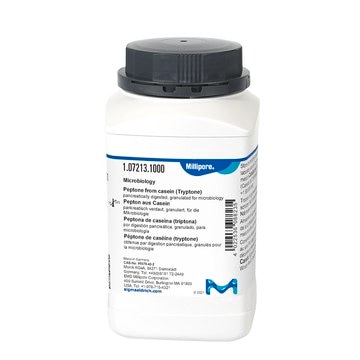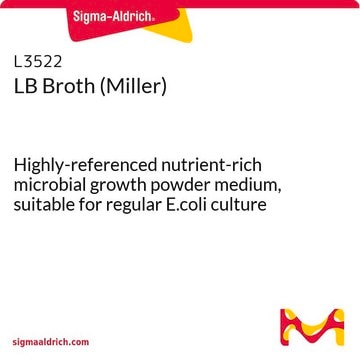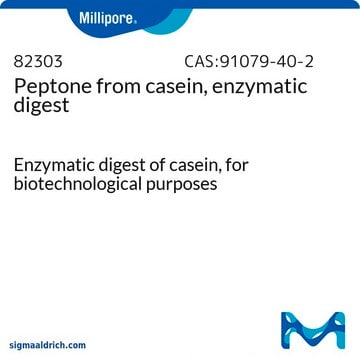T2559
EZMix Tryptone
Pancreatic digest of casein
Synonym(s):
Peptone from casein
Sign Into View Organizational & Contract Pricing
All Photos(3)
About This Item
Recommended Products
grade
Molecular Biology
for molecular biology
sterility
non-sterile
form
powder
storage temp.
room temp
suitability
nonselective for Escherichia coli
nonselective for coliforms
Looking for similar products? Visit Product Comparison Guide
General description
Tryptone is a peptone derived from the enzymatic digest of casein, often used in culture media. While tryptone is rich in tryptophane, it also contains a mixture of nitrogen, amino acids, and vitamins.
Application
Suitable for use as nutritional source in microbial media.
Features and Benefits
Tryptone EZMix powder provides:
- Granulated, dust-free format for safer handling and faster mixing
- Easy scale-up using larger package sizes
Legal Information
related product
Product No.
Description
Pricing
Storage Class Code
11 - Combustible Solids
WGK
WGK 1
Flash Point(F)
Not applicable
Flash Point(C)
Not applicable
Personal Protective Equipment
dust mask type N95 (US), Eyeshields, Gloves
Choose from one of the most recent versions:
Certificates of Analysis (COA)
Lot/Batch Number
Don't see the Right Version?
If you require a particular version, you can look up a specific certificate by the Lot or Batch number.
Already Own This Product?
Find documentation for the products that you have recently purchased in the Document Library.
Customers Also Viewed
Roger D Reidelberger et al.
American journal of physiology. Regulatory, integrative and comparative physiology, 285(2), R429-R437 (2003-05-10)
Type A cholecystokinin receptor (CCKAR) antagonists differing in blood-brain barrier permeability were used to test the hypothesis that satiety is mediated, in part, by CCK action at CCKARs located peripheral to the blood-brain barrier. At dark onset, non-food-deprived rats received
Roger D Reidelberger et al.
American journal of physiology. Regulatory, integrative and comparative physiology, 286(6), R1005-R1012 (2004-01-01)
CCK type 1 (CCK1) receptor antagonists differing in blood-brain barrier permeability were used to test the hypothesis that satiety is mediated in part by CCK action at CCK1 receptors on vagal sensory nerves innervating the small intestine. Devazepide penetrates the
Roger D Reidelberger et al.
American journal of physiology. Regulatory, integrative and comparative physiology, 284(1), R66-R75 (2002-10-22)
Type A CCK receptor (CCKAR) antagonists differing in blood-brain barrier permeability [devazepide penetrates; the dicyclohexylammonium salt of Nalpha-3-quinolinoyl-d-Glu-N,N-dipentylamide (A-70104) does not] were used to test the hypothesis that duodenal nutrient-induced inhibition of gastric emptying is mediated by CCKARs located peripheral
Vagelis Economou et al.
Food additives and contaminants, 24(8), 820-832 (2007-07-07)
Temperature abuse of tuna (Thunnus alalunga) was carried out in order to assess the histamine buildup in fish-processing facilities where fish can be exposed to high temperatures for short periods of time. Histamine production was studied in tuna loins under
Roger D Reidelberger et al.
American journal of physiology. Regulatory, integrative and comparative physiology, 284(2), R389-R398 (2002-11-05)
Type A cholecystokinin receptor (CCKAR) antagonists differing in blood-brain barrier permeability were used to test the hypothesis that duodenal delivery of protein, carbohydrate, and fat produces satiety in part by an essential CCK action at CCKARs located peripheral to the
Our team of scientists has experience in all areas of research including Life Science, Material Science, Chemical Synthesis, Chromatography, Analytical and many others.
Contact Technical Service










